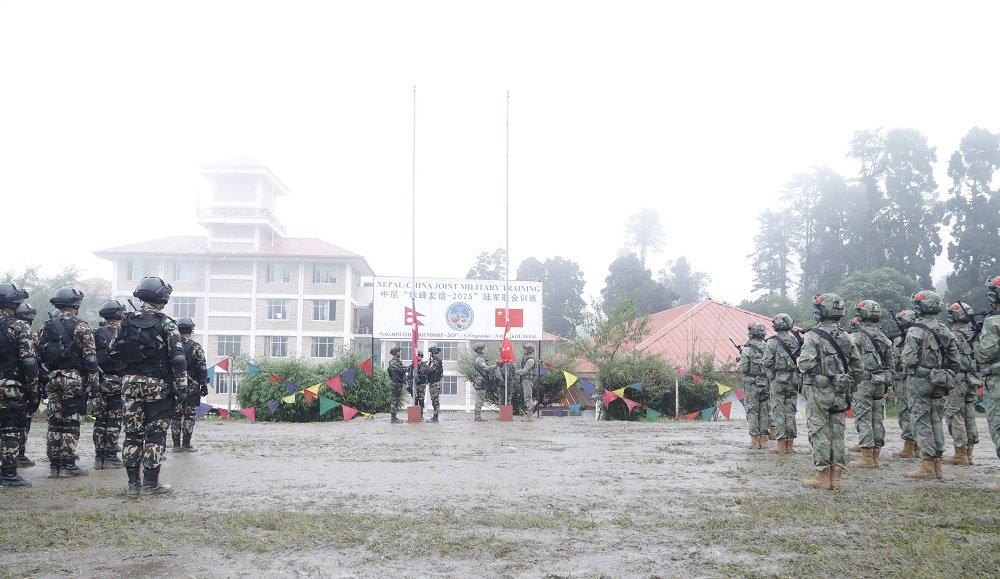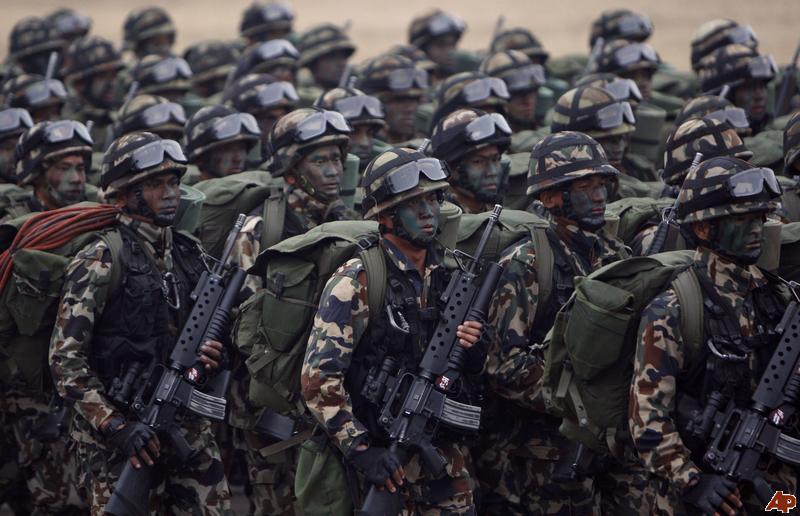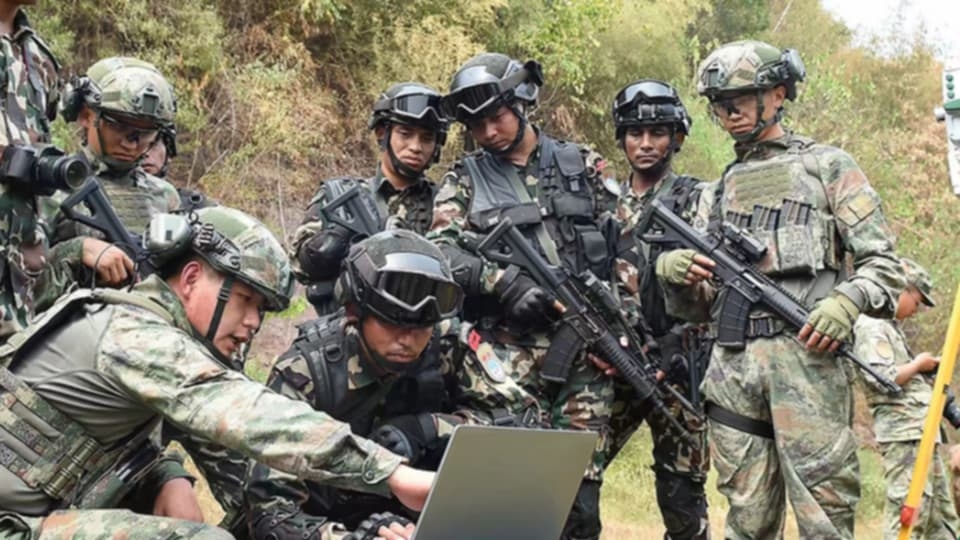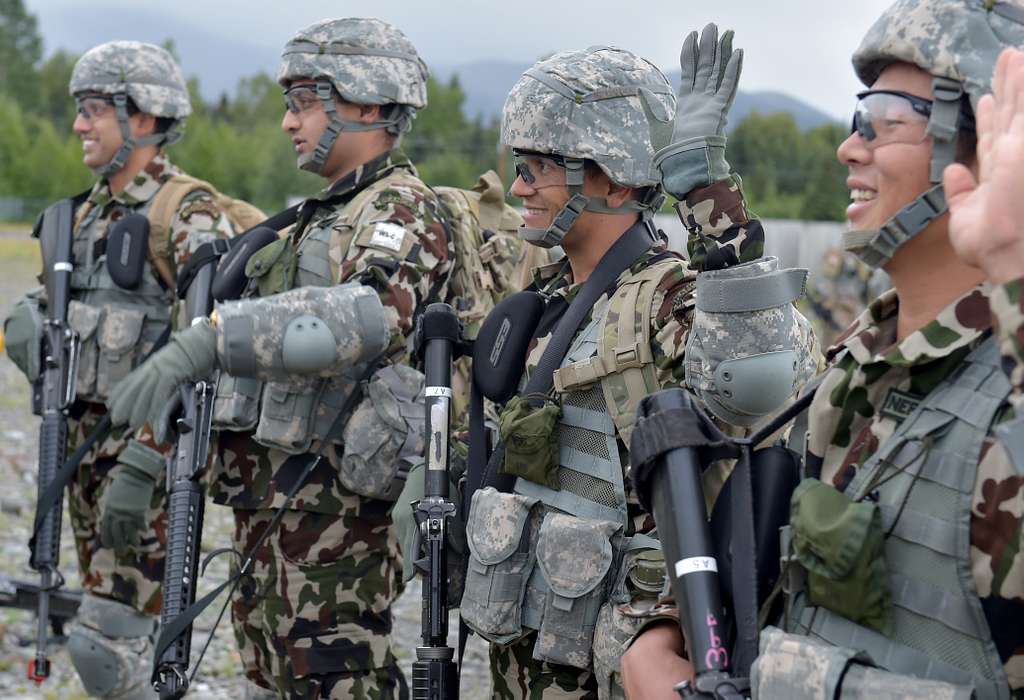
Nepal maintains a balancing act—leveraging Chinese expertise, preserving sovereignty, and sustaining ties with India—highlighting how defense diplomacy is closely linked with broader foreign policy, trade, and strategic objectives in the Himalayas.

KATHMANDU: The fifth edition of the Nepal–China joint military exercise, Sagarmatha Friendship, has kicked off today in Kathmandu.
Around 150 soldiers from the Nepal Army and China’s People’s Liberation Army are participating in platoon-level drills focusing on counter-terrorism, disaster response, high-altitude operations, and joint operational readiness.
Beyond technical training, Sagarmatha Friendship highlights China’s expanding role in Nepal’s defense sector, even as Nepal carefully manages its relationships with its northern neighbor China, southern neighbor India, and other global powers, including the United States.
The exercise builds on prior editions since 2017 and reflects broader geopolitical considerations.
This explainer will outline the history, political context, structural challenges, and evolving significance of the drills, showing how they strengthen Nepal’s technical readiness while reflecting its balancing act between China, India, and other powers.
What is the Sagarmatha Friendship exercise?
Sagarmatha Friendship is a bilateral military exercise between the Nepal Army (NA) and China’s People’s Liberation Army (PLA), first launched in April 2017.
Its primary objectives are to enhance interoperability, operational readiness, counter-terrorism capabilities, and disaster response skills while facilitating professional exchanges between the two armies.
The training encompasses rappelling, fast roping, improvised explosive device (IED) detection, checkpoint management, squad tactics, armed rescue operations, drone operations, and emergency response.
Over the years, the exercises have also incorporated joint research in disaster management, including responses to earthquakes, landslides, and avalanches, reflecting Nepal’s challenging terrain.
While the drills are technical in nature, they also carry strategic significance: they help China cultivate influence within Nepal’s military, and they allow Nepal to access training, equipment, and expertise that complement its existing capabilities.
The exercises are framed as routine bilateral cooperation, emphasizing skill development and professional exchange rather than confrontation.
How many editions of the exercise have been held and when?
Since its launch in 2017, the Sagarmatha Friendship exercise has been conducted five times.
The inaugural edition was organized in Kathmandu in April 2017, followed by the second in Chengdu, China, in September 2018.
The third was held in Nepal during August–September 2019.
From 2020 to 2022, the drills were suspended due to COVID-19 restrictions, including border closures that limited personnel and equipment movement.
The fourth edition resumed in Chongqing, China, in September–October 2024, with a focus on urban counter-terrorism, squad-level tactics, and disaster response.
This year, the fifth edition has commenced in Kathmandu on September 7, 2025 with around 150 soldiers participating in platoon-level training.
Each successive edition has gradually expanded in scope, incorporating high-altitude operations, disaster response, and professional officer exchanges, while maintaining the core emphasis on counter-terrorism.
The exercises have also grown in geopolitical relevance, reflecting China’s increasing military presence and influence in Nepal, and Nepal’s continuing efforts to balance relationships with both China and India.

How was the first Sagarmatha exercise conducted?
The first Sagarmatha Friendship exercise took place in April 2017 in Kathmandu under the leadership of then–Prime Minister Pushpa Kamal Dahal ‘Prachanda,’ who now serves as the leader of the main opposition in Parliament.
It was initially planned as a battalion-scale counter-terrorism drill, named after Mount Everest, or “Sagarmatha,” symbolizing the shared Nepal–China border.
China’s then-Defense Minister Chang Wanquan visited Kathmandu in March 2017 to prepare for the exercise, marking the first visit by a Chinese defense minister in 15 years. However, due to lobbying from the Indian government, the scale of the exercise was curtailed and largely confined to a military school rather than field deployments.
Despite this reduction, the exercise marked a significant milestone, representing the first structured joint military engagement between the two nations.
The exercise focused on counter-terrorism, operational coordination, and disaster response, while also marking a new phase of military cooperation between Nepal and China. For Nepal, it served as an opportunity to gain exposure to additional expertise and resources, creating a basis for future exercises and professional exchanges.
How did India respond to the initial Nepal-China drills?
India closely observed the first Sagarmatha exercises, perceiving them as a challenge to its longstanding influence in Nepal. Relations between India and Nepal were already strained following the 2015 trade disruption, which Nepal attributed to an unofficial Indian blockade, though India consistently denied the allegation.
Against this backdrop, Nepal’s engagement with China, including increased trade and military cooperation, drew heightened Indian attention. New Delhi sought to maintain leverage through diplomacy, highlighting centuries-old cultural, religious, and social ties.
India hosted official visits, provided developmental assistance, and emphasized cooperation on electoral processes to strengthen bilateral ties. These steps were designed to counterbalance China’s growing presence and remind Kathmandu of India’s enduring role as a neighbor and ally.
The Indian response demonstrates how regional geopolitics influence Nepal’s military collaborations, compelling it to weigh both northern and southern neighbors when planning exercises, officer training, and broader strategic partnerships.
How did Nepal’s domestic politics shape China’s military engagement?
Nepal’s domestic political landscape has played a key role in shaping its military cooperation with China. During the tenure of then-Prime Minister Pushpa Kamal Dahal ‘Prachanda’, joint exercises were planned on a larger scale, aiming for battalion-level operations with a focus on counter-terrorism, disaster response, and officer training.
These initiatives received support from visiting Chinese delegations, including then Defense Minister Chang Wanquan. However, with the change in government leadership and the transition to Sher Bahadur Deuba, the exercises were reduced in scale and confined largely to training activities within military schools.
Shifts in political leadership have therefore influenced the size, scope, and ambition of Nepal–China defense cooperation. These decisions have extended to procurement and training, such as sourcing equipment and ammunition, reflecting how Nepal balances its operational requirements with broader political sensitivities while maintaining constructive engagement with both of its large neighbors.

Why does Nepal matter to China’s security calculus?
China views Nepal as strategically important because of its position along the southern boundary. Nepal shares a 1,414-kilometer mountainous border with China’s Tibet, a region that holds key importance for Beijing in terms of security, energy, and water resources.
Tibet’s glaciers feed rivers critical for Chinese agriculture and hydropower, making stability in Nepal a priority. Nepal’s consistent adherence to the “One China” policy reassures Beijing, limiting political activity by Tibetan, Uyghur, or Taiwanese groups.
Beyond security, China seeks to limit Indian and Western influence in Nepal, and the Nepal Army is considered a more reliable partner than Nepal’s often-fractious political parties.
From Nepal’s perspective, engaging China offers infrastructure, training, and strategic support, but carries the risk of dependence and potential tension with India. This makes Nepal a critical geographic and diplomatic buffer, requiring careful management to maintain sovereignty and balanced foreign relations.
Which are the traditional Nepal–China border points from east to west?
Nepal’s 1,414-kilometer Himalayan border with China historically included numerous high-altitude passes used for trade, pilgrimage, and local commerce.
From east to west, key passes include Taplejung’s Tiptala Bhanjyang–Riwa, reopened for vehicular trade in 2025; Sankhuwasabha’s Kimathangka–Chentang; Solukhumbu’s Nangpa La; Dolakha’s Lapchi–Ramding, reopened in 2023; Sindhupalchowk’s Tatopani–Zhangmu; and Rasuwa’s Rasuwagadhi–Kerung.
Shifts in political leadership have therefore influenced the size, scope, and ambition of Nepal–China defense cooperation.
Mustang’s Korala pass, Dolpa’s Marim and Kyato, Mugu’s Nakchenangla, Humla’s Hilsa–Purang, Bajhang’s Urai–Biling Bhanjyang, and Darchula’s Tinkar complete the western frontier.
These passes have been operational with roads, bridges, and customs posts, facilitating trade and tourism. For China, they enable oversight of Tibet, trade control, and influence over Nepal’s security decisions.
For Nepal, they offer economic opportunities but also highlight the need to balance dependence on Chinese infrastructure with sovereignty and relations with India, especially in strategic border districts.
How have recent Chinese military delegations influenced Nepal-China defense relations?
Recent Chinese military delegations have reinforced ties with Nepal while advancing Beijing’s strategic interests.
In August 2023, Major General Yue Ande from the PLA’s Tibet Military Command visited Kathmandu to revive the Sagarmatha exercises and offer Nepal Army officers placements at Chinese military academies, including the College of Defense Studies (CDS).
In March 2024, Major General Zhang Baoqun visited Nepal, touring military institutions and discussing proposals such as armored personnel carrier (APC) procurement, the establishment of an ammunition plant, resuming Sagarmatha exercises, and expanding officer training.
These delegations aim to enhance operational readiness, disaster response capabilities, and professional development while increasing China’s influence in Nepal’s military.
However, Nepal’s historically close ties with India and internal political shifts influence the scope of cooperation. These engagements highlight Beijing’s strategic use of targeted military diplomacy, balancing training support with measured influence, while Nepal navigates competing regional pressures.
What structural challenges have historically limited Nepal-China military ties?
Nepal-China military relations have historically been limited due to structural and political factors. During the monarchy, most military issues were addressed through the palace rather than institutional channels.
After Nepal became a republic in 2008, China sought to diversify engagement through grants, training, infrastructure development, and exercises focused on UN peacekeeping, disaster management, and internal security.
However, enduring Nepal–India military ties—including joint exercises, material support, and Gurkha personnel—restricted China’s influence.
Border closures and pandemic-related restrictions between 2020 and 2023 further impeded cooperation, demonstrating the fragility of military ties. These structural limitations, combined with political transitions and India’s presence, have constrained the depth of China-Nepal defense collaboration.
Consequently, while exercises and officer training offer targeted skill-building, the broader bilateral military relationship remains episodic, carefully calibrated, and dependent on domestic political orientation and regional geopolitics.
How has post-COVID military cooperation resumed between Nepal and China?
After COVID-19 restrictions eased in mid-2023, China actively revived military engagement with Nepal.
In August 2023, Major General Yue Ande led a delegation from the PLA’s Tibet Command, reinstating the Sagarmatha exercises and offering Nepal Army officers placements in Chinese military academies, including the College of Defense Studies (CDS).
The March 2024 visit by Major General Zhang Baoqun further promoted proposals to procure 26 armored personnel carriers from China, establish an ammunition plant, expand officer training, and resume joint exercises. These initiatives aim to enhance operational readiness, professional exchange, and disaster response skills.
The March 2024 visit by Major General Zhang Baoqun further promoted proposals to procure 26 armored personnel carriers from China, establish an ammunition plant, expand officer training, and resume joint exercises.
While Nepal’s leadership evaluates these proposals carefully, domestic political dynamics and India’s historical military influence shape implementation.
The post-COVID revival demonstrates a cautious but deliberate return to structured military cooperation, reinforcing China’s influence while allowing Nepal to access training, expertise, and equipment to strengthen its own defense capabilities.
What controversies surround Chinese military proposals in Nepal?
Several Chinese military proposals have generated controversy in Nepal.
In 2023, Nepal’s proposed procurement of 26 armored personnel carriers from China’s North Industries Group Corporation Limited (NORINCO) drew allegations of corruption and price inflation, leading the government to temporarily freeze the contract.
The Nepal Army rejected the claims. Reports indicated that then-Prime Minister Pushpa Kamal Dahal ‘Prachanda’ instructed the halt ahead of his official visit to India on 31 May 2023.
The suspension reflected both domestic scrutiny and the timing of high-level diplomatic engagements.
Similarly, Chinese ammunition, once a primary supplier, was supplanted in 2022 by India’s SSS Defence due to quality concerns. Zhang Baoqun’s delegation proposed building an ammunition plant, potentially undermining India’s re-entry into the Nepal Army supply chain.
Additionally, attempts to resume Sagarmatha exercises have been politically sensitive, reflecting the government’s need to balance domestic interests and regional diplomacy.
These controversies underscore how defense procurement and joint military exercises are entwined with geopolitics, domestic politics, and strategic competition, highlighting the challenges Nepal faces in maintaining autonomy while leveraging Chinese expertise and resources.
How does Sagarmatha Friendship compare to Nepal’s military exercises with India?
Sagarmatha Friendship differs from India-Nepal exercises such as Surya Kiran in focus and strategic significance. While both aim to enhance interoperability, training, and disaster preparedness, Sagarmatha Friendship emphasizes Nepal-China military cooperation, including counter-terrorism, high-altitude operations, and professional officer exchanges.
Exercises with India, such as the annual Surya Kiran, focus on joint operations that strengthen long-standing defense ties and interoperability, including Gurkha integration.
The drills enhance capabilities in jungle warfare, counter-terrorism, disaster relief, and urban operations, combining tactical training with cultural and sporting activities to foster camaraderie.
These exercises emphasize operational readiness, coordination, and mutual understanding, reflecting the historical military relationship between Nepal and India while preparing forces for diverse security and humanitarian scenarios.
Sagarmatha Friendship also carries geopolitical weight, signaling China’s increasing influence in Nepal, whereas exercises with India are part of established bilateral military protocols.
The contrast reflects Nepal’s balancing act: engaging China for skill development and resources while maintaining traditional ties with India.
Strategically, Sagarmatha Friendship provides exposure to Chinese doctrines and disaster-response practices, complementing, rather than replacing, India-focused cooperation.
Both sets of exercises contribute to Nepal’s operational readiness, professional development, and regional strategic positioning.

How do Nepal’s joint military exercises with China and the US reflect its defense partnerships and engagement with initiatives like the BRI and MCC?
Nepal regularly conducts joint military exercises with both China and the US to strengthen operational readiness, disaster response, and specialized skills.
With the US, exercises such as Pacific Angel (humanitarian disaster relief and search-and-rescue), Balance Nail (disaster management, counter-terrorism, mountaineering, and UN peacekeeping), and joint training exchanges with Naval Special Warfare units (including swift-water rescue and high-altitude mountaineering) provide diverse operational and technical expertise.
During Pacific Angel 24, the Nepal Army trained with the upgraded US Air Force HC-130J Combat King aircraft, capable of long-range search-and-rescue and reconnaissance missions.
These exercises occur alongside Nepal’s engagements with China and other partners within broader strategic and development frameworks, including the Belt and Road Initiative (BRI) and the Millennium Challenge Corporation (MCC).
The drills enhance Nepal’s disaster-response capacity, technical skills, and military readiness while reflecting a neutral, pragmatic approach to regional security and international cooperation.
How did Nepal-China military ties evolve historically?
China’s military engagement with Nepal remained limited until recent decades. During the monarchy, China primarily engaged with the palace rather than institutional military channels.
Following the 1974 dismantling of Tibetan Khampa bases and King Birendra’s procurement of Chinese weapons, occasional goodwill gestures occurred.
During the 1990s Maoist insurgency and King Gyanendra’s 2005 takeover, China supplied weapons, training, and logistical support when India, the U.S., and Britain withheld aid.
After Nepal became a republic in 2008, China adjusted to work with Maoist leaders, providing grants, officer training, and support for disaster-response institutions.
The 2015 blockade and strained India-Nepal relations accelerated engagement, culminating in the first Sagarmatha Friendship exercise in 2017.
Since then, exercises, officer training, and equipment support have deepened ties, while remaining episodic and influenced by regional geopolitics, domestic politics, and Nepal’s enduring balancing between China and India.
What strategic benefits does Nepal gain from China’s military engagement?
Nepal benefits from China’s military engagement through access to training, modern equipment, disaster-response expertise, and professional officer exchanges.
Sagarmatha Friendship exercises provide hands-on skills in counter-terrorism, high-altitude operations, and emergency response, complementing the army’s existing capabilities.
Beyond technical advantages, engagement diversifies Nepal’s strategic partnerships, reducing sole reliance on India while signaling its non-aligned stance.
Placement in Chinese military academies, including the National Defense University (NDU), allows Nepali officers to pursue advanced strategic studies, earning degrees while gaining exposure to Chinese doctrines.
Equipment grants, APC procurement, and proposed ammunition plants enhance operational readiness.
Beyond technical advantages, engagement diversifies Nepal’s strategic partnerships, reducing sole reliance on India while signaling its non-aligned stance.
These benefits are significant, given Nepal’s challenging terrain, exposure to natural disasters, and evolving regional dynamics.
However, the challenge lies in leveraging Chinese support without compromising sovereignty or traditional ties with India, ensuring Nepal retains flexibility in procurement, training, and broader defense strategy.
How do the Sagarmatha drills fit into broader Nepal-China relations?
Sagarmatha Friendship exercises are a key component of Nepal-China bilateral relations, blending military, political, and strategic dimensions.
Beyond operational training, the drills illustrate China’s desire to cultivate influence within Nepal’s military while providing Nepal access to skills, resources, and equipment.
Exercises strengthen disaster preparedness, counter-terrorism response, and officer professional development, complementing economic and infrastructural ties under initiatives such as the Belt and Road framework.
Strategically, they serve as a soft-power tool for China, signaling a reliable partnership in a region historically influenced by India.
For Nepal, Sagarmatha Friendship exercises allow skill-building, diversification of military partnerships, and enhanced operational readiness, all while navigating regional geopolitics.
By participating in these drills, Nepal maintains a balancing act—leveraging Chinese expertise, preserving sovereignty, and sustaining ties with India—highlighting how defense diplomacy is closely linked with broader foreign policy, trade, and strategic objectives in the Himalayas.